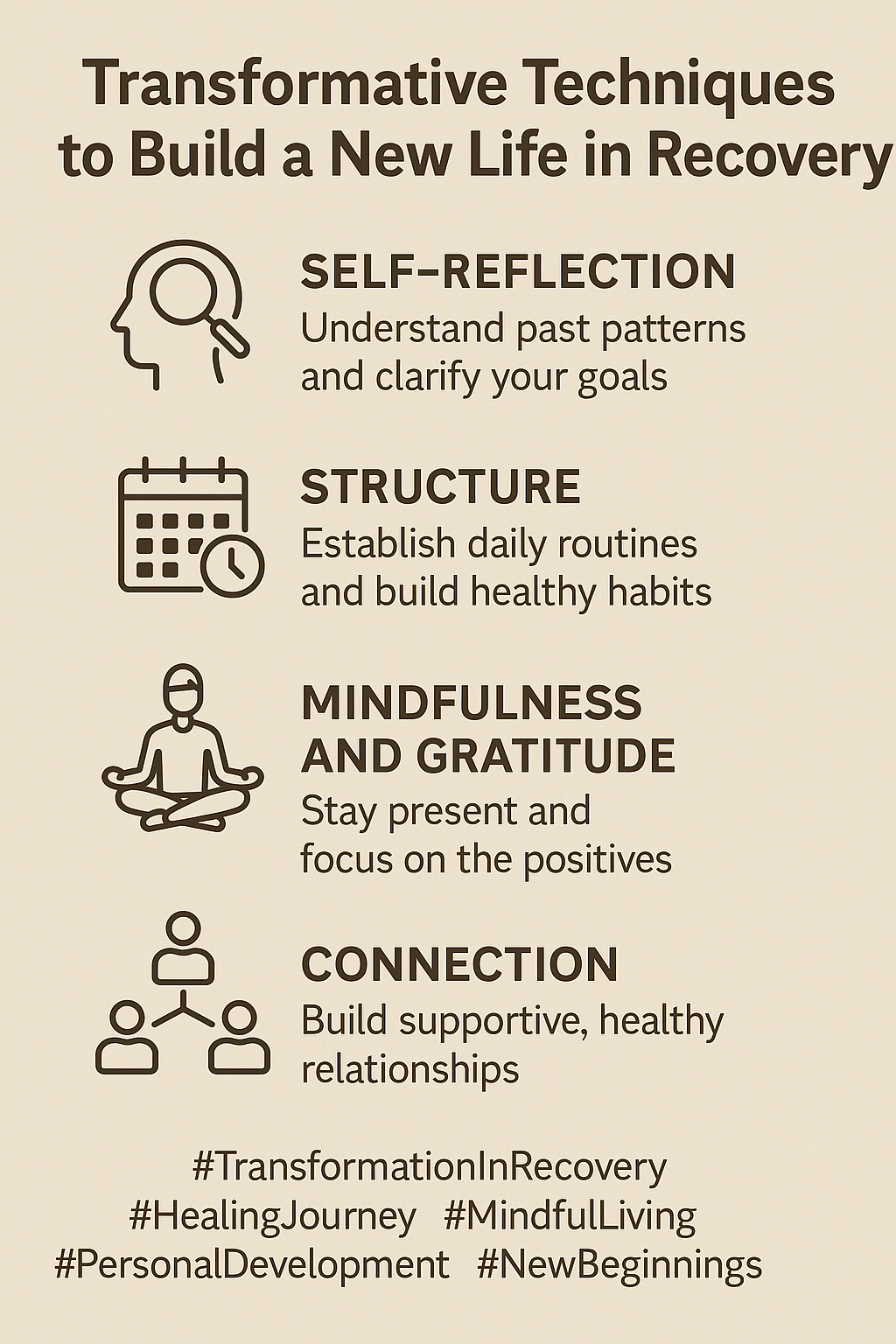Building a new life from the ground up can feel overwhelming, especially when you’re facing significant transitions, breaking old habits, or starting fresh in unfamiliar territory. It’s natural to feel uncertain about where to begin or how to stay motivated when everything feels new. But fundamental transformation doesn’t happen overnight—it grows through intentional actions, self-reflection, and consistent effort. By focusing on a few powerful techniques, you can start reshaping your mindset, strengthening your routines, and creating space for growth and purpose. These approaches aren’t just about changing what you do—they’re about redefining how you see yourself and what’s possible. In this guide, I’ll share practical strategies to help you shift your perspective, build healthy habits, and create meaningful, lasting change from the inside out.
Understanding Why You Want Change
Designing a new life begins with exploring why you want things to change. Without a clear sense of purpose, it’s easy to get lost or bounce from one new idea to the next without real direction. Pinning down your “why” gives you an anchor for every new move you make.
Sometimes, it’s about running away from what isn’t working, whether that’s an unsatisfying routine, a toxic environment, or just the feeling that something is missing. At other times, the urge to grow or explore new possibilities drives significant changes. Being honest with yourself (even if the answers aren’t super clear right away) helps you stay motivated and push through the tough parts. Take a moment to write down what’s pushing you towards making these changes. Is it a craving for greater happiness? Are you looking to build healthier connections or follow a long-held dream? Being specific adds power to your efforts.
Self-Awareness: Your Foundation for Change
Before making fundamental shifts, developing self-awareness is really important. This involves understanding your thought patterns, emotional triggers, daily habits, and how you cope with setbacks or stress. Journaling, even just five minutes a day, is a great way to spot trends or things that keep tripping you up.
If you’re more of a talker, working with a therapist or coach can also open your eyes to blind spots you might otherwise miss. The goal is to gently hold up a mirror to see what’s working and what’s not, so you know exactly what to tweak as you move forward. Self-awareness lets you spot subtle patterns—maybe you react to stress in ways that don’t help, or you shy away from opportunities out of old fears. Over time, this insight builds confidence.
- Tip: Try a “self-audit” at the end of the week: list your high points, low points, and the biggest lessons learned.
Shifting Your Mindset and Beliefs
Old beliefs can feel like concrete blocks around your ankles, especially when they’re shaped by years of self-doubt or outside expectations. Switching up your mindset doesn’t mean pretending everything is perfect. It’s about being open to growth, letting go of limiting beliefs, and treating yourself with patience as you get accustomed to new things.
One practical trick I often use is positive reframing. Instead of thinking, “I always mess things up,” I’ll try flipping it to, “I’m learning as I go; setbacks are just part of the process.” Repeating these new beliefs, even if they feel awkward at first, can help rewire your perspective on challenges.
- Visualization is beneficial: Spend a few minutes each day picturing your future self succeeding at the tough stuff. It’s surprisingly motivating; adding a vision board or using sticky notes as reminders can be helpful.
Building Healthier Habits, One Step at a Time
Changing your habits isn’t about a total overhaul overnight; it’s all about stacking small wins that snowball over time. Start with just one or two habits you can realistically tackle. For example, waking up 20 minutes earlier for a morning walk, swapping screen time before bed for reading, or preparing healthy lunches.
The “habit stacking” method is something I’ve found really handy: attach a new habit to an existing one. Say you already make coffee every morning, try fitting in five minutes of mindful breathing while it brews. Linking a new action with a routine makes sticking to it way easier.
- Pick a habit that excites you and start tiny.
- Track your consistency with a calendar or an app (seeing your streak grow feels good!).
- Expect to slip sometimes and restart; no guilt trips needed.
Creating an Inspiring Environment
Your physical and social surroundings play a huge role in supporting or sabotaging your new chapter. If your space feels outdated or cluttered, a quick decluttering session or adding some desk plants can boost your mood quickly. More importantly, check in with the people you spend time with. Hanging out with people who lift you and support your goals can give your motivation a significant boost.
If you’re making more profound changes, connecting with like-minded groups online or in your local community works wonders for accountability and inspiration. Small meetups, hobby clubs, or volunteering all put you in touch with others who “get it.” And remember, changing your workspace or daily scenery, such as working from a library or a new café, can help break out of old ruts and stimulate creativity.
Practical Steps for Personal Growth
Personal growth may sound like a big, abstract concept, but it occurs through simple, everyday actions. Here are a few hands-on ways to keep progressing:
- Daily Reflection: End each day noting something you’re proud of; no win is too small. This helps you build momentum and self-trust.
- Read and Listen: Books, podcasts, or blogs in areas you want to improve (career, mindfulness, creativity), keep your mind buzzing with new ideas.
- Skill Building: Set a monthly goal, such as learning a new tech tool or developing a cooking skill. Online platforms like Coursera or Skillshare are super handy for this.
- Mentorship: Intentionally seek advice from those you admire and look up to, whether through formal programs, online platforms, or community events.
Dealing with Setbacks and Staying Flexible
No new start goes perfectly. There’ll be rough days when motivation tanks or life throws a curveball. Building resilience is about rolling with those hits instead of giving up. I try to see setbacks as just regular detours, not signs to toss out all my plans.
Talking with a trusted friend, tweaking my routine, or just taking a break reminds me that rough patches pass. Staying flexible helps, too. Sometimes your vision for your new life changes as you go, and that’s completely normal. Be willing to adjust goals or timelines when life demands it—flexibility keeps frustration at bay.
Quick Resilience Boosters
- Practicing gratitude daily (even if it’s just a sticky note reminder).
- Pausing to breathe when stress spikes; the classic “count to 5” trick really works.
- Gently reviewing (not judging) what caused a setback so you’re better prepared next time.
- Taking short walks or stepping outside for fresh air can quickly reset your mindset.
Lifestyle Changes That Make a Noticeable Difference
Some changes make a surprisingly significant impact on your overall well-being:
- Declutter regularly: A tidy living space feels better and helps your mind stay clear. Tackle one room or area each week to avoid feeling overwhelmed.
- Exercise consistently: It doesn’t take much; walking or stretching a few minutes a day is beneficial. Try new activities, such as dance, yoga, or nature hikes, to keep things interesting.
- Eat more nutritious foods: Energetic, satisfying meals help your body and mood function optimally. Plan out meals ahead of time to avoid last-minute unhealthy options.
- Mindful spending: Reevaluating what you actually need reduces impulse buys and financial stress. Set small savings goals and treat saving as a positive habit, not a chore.
- Quality sleep: Getting enough restful sleep not only recharges your body but also sharpens your mind for new challenges.
Common Questions About Transforming Your Life
Here are a few questions that come up regularly as folks start over or build something new:
Question: How do I stay motivated when progress feels slow?
Answer: Focus on your “why” and celebrate every step, no matter how small. Having an accountability buddy, even just a check-in text, can give you an extra push. Mix in some small, regular rewards to keep it fun.
Question: Is it possible to change at any age?
Answer: Definitely. Growth isn’t limited by age; being open to learning and keeping a playful spirit makes all the difference, whether you’re 18 or 80. Life is all about permitting yourself to change directions at any stage.
Question: What if my friends or family don’t support my changes?
Answer: It can be tough, but holding firm to your personal goals matters. Try explaining your reasons and inviting them to join, but ultimately seek out new support circles if needed. Remember, your path doesn’t have to look like everyone else’s. Surround yourself with reminders of your growth and the positive changes you’re making.
Putting it All Together: The Ongoing Adventure
Transforming your life is more about showing up for yourself, over and over, than it is about sticking to a perfect routine or image. Every small choice, habit adjustment, or mindset shift adds up over time. While the process will involve experimentation and, sometimes, a little backtracking, the result is a life that feels more your own.
Embrace the process, continue learning from the ups and downs, and don’t hesitate to reach out for help or support within the community. A new life isn’t a quick fix; it’s all the tiny, day-to-day choices you make adding up to significant changes you can feel good about. So, stay curious, be kind to yourself, and celebrate your progress along the way—the ride itself is where real growth happens.
Video: Addiction Recovery Secrets Successful People Use Daily

